Back in the late 1980s when the U.S. military retired the 1911 for the Beretta M9, the Marine Expeditionary Unit (Special Operations Capable), or MEUSOC, decided to stick with the 45 Auto 1911 platform because it was the only pistol at the time that could stand up to the use the MEUSOC teams doled out. The MEUSOC guys detailed the new features and specifications they wanted on their modernized version of the 1911, and the armorers at Quantico built the guns. Most of these guns were built on original, used M1911A1 G.I. frames. The remaining parts for the builds were a precise list that transformed the G.I. 1911s into modern combat handguns. MEUSOC operators provided feedback to the armorers on the guns, and there were four variations of these guns built. Some of the parts used in the builds reads like a who’s who of custom gun-builder pieces. Parts included Clark or Wilson Combat beavertail grip safeties, Pachmayr Gripper grips, MGW commander hammers, Videcki steel triggers, Bar-Sto barrels, Springfield Armory slides, Ed Brown safeties, Caspian mainspring housings, and more, all the way down to the smaller pins, the sear, and other parts. Common to all MEUSOC pistols were fixed sights, long triggers, G.I.-style muzzle bushings, and flat mainspring housings.
Some 1911 manufacturers produce pistols in the MEUSOC style, and we wanted to take a look at these guns. These newly-made MEUSOC 1911s are not exact copies of the Quantico builds. For example, the original specs called for a lanyard loop, which have no real use on modern commercial guns, other than impeding a magazine reload with a G.I. bump-pad-less mag. The three pistols we chose for this match up include the Military Armament Corporation (MAC) 1911 JSOC 45, the Springfield Armory 1911 Loaded Marine Corps Operator, and Rock Island Armory’s 1911 A1 Tact Standard FS. All three of these share a full-size frame, are chambered in 45 Auto, and feed from a single-stack magazine. From there, the interpretation of the MEUSOC guns takes some creative license, which is fine by us as long as it works, and we can say all three of these guns performed exceptionally well, with excellent accuracy, decent triggers, user-friendly sights, and texture where you need it on a 45 Auto 1911. If you are looking for a full-size 1911, any one of the these guns will fit the bill, but our shooters expressed some preferences that made one gun our pick over the others.
How We Tested
We shot for accuracy at 25 yards using a rest, and we moved in to 7 yards for the speed-shooting portion, where we ran a modified Bill Drill by firing as fast as we could into an 8-inch circle and performing reloads. We loaded different round counts into all the pistols’ magazines as well as using new Never Unarmed eight-round 1911 magazines ($18; NeverUnarmed.com). These steel-body magazines feature a polymer follower and bumper pad and look a lot like Wilson Combat magazines, except they are a fraction of the price. We tested for slide lock back and the ability to quickly load. The Never Unarmed magazines worked well, and for the price, we rate them a Best Buy. Slide lock back was positive with all three pistols, and the magazines inserted smoothly and clicked positively in place when seated and dropped free from the pistol when the magazine catch was pressed. We fired the pistol with and without shooting gloves. The trigger guard is not that big on 1911s, though we were able to easily use a variety of shooting gloves. All the magazines were compatible, except the Armscor mag, which couldn’t be inserted into the MAC because the bumper pad was not compatible with the MAC’s mag well.
Test ammunition was an assortment of defense and training loads. Armscor 230-grain FMJ ball ammo is similar to G.I.-style ammo and is a good choice for training. For defense loads, we used Hornady Critical Duty 45 Auto +P with a 220-grain FlexLock bullet and Winchester Silver Tips with 185-grain JHPs. If you are going to run a steady diet of +P ammo, we recommend installing a Wilson Combat Shok-Buff ($6.95; WilsonCombat.com) to protect the slide from battering the frame. You can use them with any ammo type and they last about 1,000 rounds before needing replacement. Shok-Buffs are for 5-inch-barrel 1911s only. There is not enough room for them in Commander and compact-size 1911s.
Average accuracy across the three ammo choices ranged from 2.43 inches for the RIA to 2.73 inches for the MAC. The Springfield was just behind the RIA with 2.46-inch average accuracy.
The heft of these pistols makes them easier to shoot faster. Speed-shooting groups measured 1.6 inches on average for the RIA, and 2.2 and 2.6 inches for the Springfield and MAC, respectively. In the speed-shooting section we didn’t count flyers; rather, we looked at the concentration of the holes or in some cases, one massive ragged hole.
We had two failure-to-feed jams with the MAC, and we attributed this to the 1911 being new and not having enough lube on the barrel. We sprayed Hoppe’s Gun Medic on the barrel without field-stripping the gun, and the MAC ran fine from that point forward.
Military Armament Corporation 1911JSOC 45 10100536 45 Auto
$685
Gun Tests grade: A-
The MAC is a retro-style gun reminiscent of the MEUSOC-style pistol. It performed well, was accurate, and was fast to reload. We would not hesitate to use this as an EDC gun.
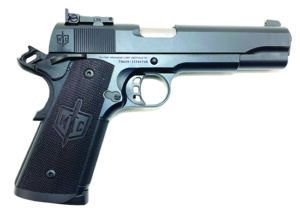
| Action | Locked breech, single-action semi-auto |
| Overall Length | 8.5 in. |
| Overall Height | 5.8 in. |
| Maximum Width | 1.4 in. |
| Weight Unloaded | 32.4 oz. |
| Weight Loaded | 41.5 oz. |
| Barrel | 5.0 in. |
| Capacity (Single Stack) | 8+1 |
| Slide | Steel, QPQ Tennifer finish |
| Slide Retraction Effort | 19.0 lbs. |
| Frame | Steel, QPQ Tennifer finish |
| Frame Front Strap Height | 2.7 in. |
| Frame Back Strap Height | 3.3 in. |
| Grips | Walnut, checkered |
| Grip Thickness (Maximum) | 1.3 in. |
| Grip Circumference (Maximum) | 5.5 in. |
| Front Sight | Brass bead on blade |
| Rear Sight | Bo-Mar adjustable |
| Trigger Pull Weight | 6.0 lbs. |
| Trigger Span Single Action | 2.8 in. |
| Magazines | 2; steel w/bump pad |
| Safety | Manual thumb, beavertail grip |
| Warranty | 1 year |
| Made In | Turkey |
| Website | MilArmamentCorp.com |
The MAC 1911 JSOC 45 is built in Turkey by Tisas, and we have had good luck testing Tisas-made 1911s. We hoped the MAC would impress us, and it did.
JSOC stands for Joint Special Operation Command, which is where we assume MAC drew its inspiration for the JSOC 45, along with the Army’s SFOD-D or Special Forces Operational Detachment, Delta — more commonly known as Delta Force. It also takes design cues from early MEUSOC guns. The MAC pistol has a retro look. The domed, GI-style slide has rear-only serrations that are vertical like an 1911A1. The rear sight is a Bo-Mar-style fully adjustable rear target sight. MEUSOC guns had fixed sights. The shooter-facing side is serrated to cut glare, and the notch offers a good sight picture. However, you will rip up the palm of your hand if you use a palm-over-slide reload technique on a reload. Use the slide stop. There is another dovetail under the rear sight that we assume is cut for a snag-free fixed sight if you should choose to replace the target sight. The front is a brass-beaded front-sight blade, which popped more on dark targets.
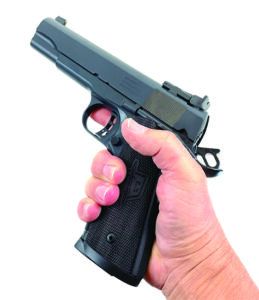
The frame/receiver does not have a rail, which gives the pistol an old-school look. The metal wears a nice matte QPQ Tennifer finish. The flat mainspring housing and front strap feature a toothy 25-lines-per-inch checkering, much like you would find on a custom pistol. It offers a sure grip in rapid fire. It also features a beveled magazine well, a feature not found on MEUSOC pistols. The tapered mag well does an excellent job of smoothly funneling the skinny single-stack magazine into the pistol.
The MAC comes with two eight-round Mec-Gar steel-body magazines with polymer followers and bumper pads. Because of the mag well, the bumper pad ensures you seat the magazine all the way. The Never Unarmed magazine was easy to seat, too, but the Springfield G.I.-style stick — sans a bumper pad — requires you to use your fingers to fully seat it, rather than a slap the bumper with the palm of your hand. All this comes in a hard case with a cleaning brush and rod.
Grips are checkered dark walnut with a laser-engraved MAC logo. We like the discreet markings on the MAC. The grip, frame, and mag well were all nicely blended.
The curved trigger is finely serrated for a good feel. There is about 1⁄8 inch of take up before the wall, then there’s a fairly crisp break after 6 pounds of pressure is applied. Again, we’d prefer a trigger closer to 4 pounds. Reset is about 1⁄8 inch.
The beavertail grip safety was comfortable to shoot, and the ambi safety clicked on and off with authority. The ambi was not as wide as the other guns, but it was lower profile, like one you would find on an everyday-carry 1911.
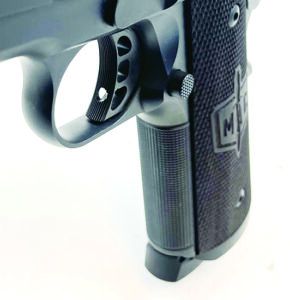
The MAC uses a G.I.-style bushing, and its cycling was fairly smooth, but not as smooth as the RIA pistol, in our opinion. After shooting the MAC for an extended period of time, we felt the checkered wood grip starting to rub the web of our hands. Wearing shooting gloves alleviated the issue, and we continued without discomfort.
The MAC averaged a group size of 2.73 inches across all ammos, which is good, but the worst of the three guns tested. Best groups measured 1.34 inches with Winchester Silver Tips. Next best was Hornady Critical Duty, which measured 2.46 inches. The Armscor ball ammo had a best group of 2.63 inches. Accuracy was good. As we mentioned, there were two initial FTFs, but that sorted out quickly, and the gun then ran well with all magazines.
The MAC was the lightest in the match up, and that showed during speed shooting. It was harder to control, and the 7-yard fast-shoot group averaged about 2.6 inches. The MAC was not as easy to control as the other guns. Where the MAC had an edge was in reloading. The mag well made reloading smoother and faster.
Our Team Said: The MAC has that dated 1980’s Delta Force demeanor, but this would be our choice for an EDC gun due to its weight, mag well, and accuracy. It lacks a rail, which makes it less functional for some shooters. The target rear sight is sharp and could snag or tear garments. We might Dremel off the top corners of the rear sight, touch it up with a Sharpie, and we would be good to go.
| 45 ACP RANGE DATA | |||
| Hornady Critical Duty 220-grain FlexLock (+P) | Military Armament Corp. 1911 JSOC 45 | Rock Island Armory 1911 A1 Tact Standard FS Marine Corps Operator | Springfield 1911 Loaded Marine Corps Operator |
| Average Velocity | 1054 fps | 1003 fps | 1052 fps |
| Muzzle Energy | 510 ft.-lbs. | 492 ft.-lbs. | 541 ft.-lbs. |
| Smallest Group | 2.46 in. | 2.21 in. | 2.06 in. |
| Average Group | 3.35 in. | 2.60 in. | 2.26 in. |
| Armscor 230-grain FMJ | Military Armament Corp. 1911 JSOC 45 | Rock Island Armory 1911 A1 Tact Standard FS | Springfield 1911 Loaded Marine Corps Operator |
| Average Velocity | 879 fps | 828 fps | 887 fps |
| Muzzle Energy | 394 ft.-lbs. | 350 ft.-lbs. | 401 ft.-lbs. |
| Smallest Group | 2.63 in. | 2.29 in. | 1.93 in. |
| Average Group | 2.71 in. | 2.37 in. | 2.20 in. |
| Winchester Silver Tip 185-grain JHP | Military Armament Corp. 1911 JSOC 45 | Rock Island Armory 1911 A1 Tact Standard FS | Springfield 1911 Loaded Marine Corps Operator |
| Average Velocity | 991 fps | 972 fps | 994 fps |
| Muzzle Energy | 403 ft.-lbs. | 388 ft.-lbs. | 406 ft.-lbs. |
| Smallest Group | 1.34 in. | 1.49 in. | 2.77 in. |
| Average Group | 2.15 in. | 2.33 in. | 2.93 in. |
To collect accuracy data, we fired five-shot groups at 25 yards from a bench using a rest. We recorded velocities using a Garmin Zero C1 Pro chronograph.
Written and photographed by Robert Sadowski, using evaluations from Gun Tests Team members. GT



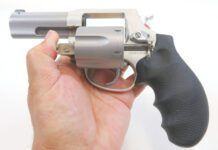
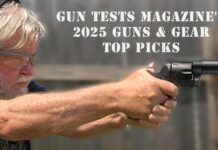
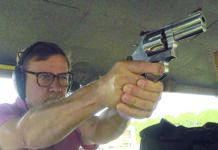
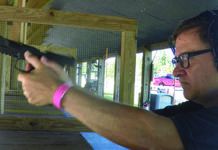
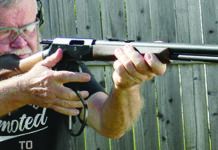
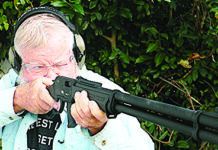
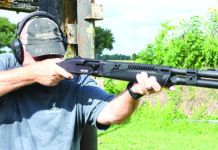
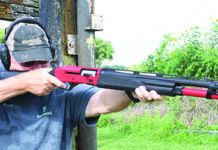
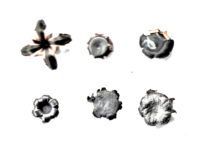
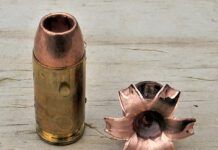

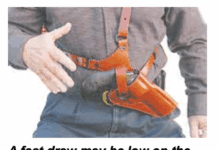
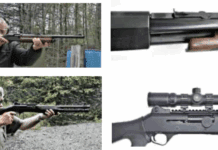
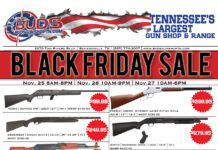



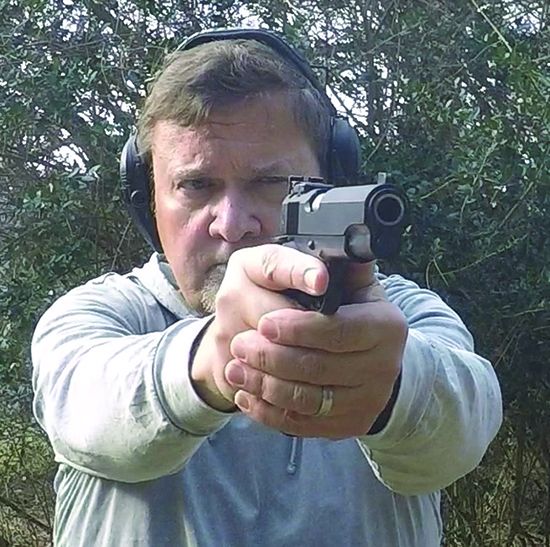

Fantastic article on affordable 1911’s that are quality firearms.
Respectfully, If using Bar-Sto barrels, why the “G.I.-style muzzle bushings?”
Those Bar-Sto barrels have their own, ‘accurizing’ bushings, specifically for tightening against the expanding, muzzle circumference; and thereby, ‘locking’ those loose, 1911 barrels with the slide.
Thanks!
Semper Fi